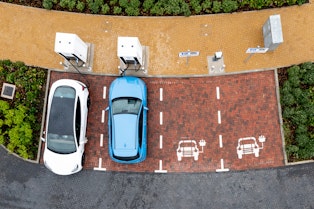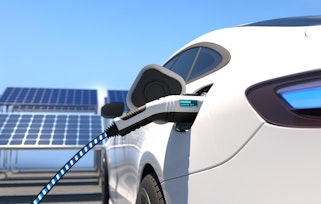Pacific Green is committed to speeding the energy transition around the world. We work in markets that are leading and others that could be considered laggards. And Australia is a special case, something of an involuntary leader.
Despite longstanding federal support for fossil fuels, states such as South Australia have seen soaring levels of renewables adoption, to the point that some of Australia’s grids are among the greenest in the world.
Tasmania, for example, got practically 100% of its electricity from renewable sources in 2021. South Australia managed almost 67%. And Victoria and Western Australia claimed 33% and 32%, respectively. That is on a par with European clean energy leaders such as Denmark and Portugal.
But there is one area where Australia still lags many developed economies. Although demand for electric vehicles (EVs) has increased massively in 2022, by 65%, battery-powered cars still only accounted for little over 3% of total sales in the year.

And that was largely down to people buying Teslas, with the company’s Model 3 making up a third of all electric vehicle sales in Australia during 2022, and the Model Y representing another fifth.
For comparison, electric models make up 23% of all new car sales in New Zealand, 8% in Singapore and 6% in the US.
Australia’s sluggish adoption of electric vehicles is mainly down to the high price of the models and the availability and cost of charging stations, according to research by Macquarie Business School.
"Currently there are 291 public, fast-charging locations around Australia,” says energy and environmental economist Dr Marjan Nazifi, a lecturer in the Department of Economics at the institution.
“The perceived limited driving range of EVs means the presence of adequate charging infrastructure will be important to EV adoption.”
Australia’s new federal government is looking to change this in an effort to ensure 90% of Australian vehicles are electric by 2050.
September 2022 saw the publication of a 53-page report on recommendations for electric vehicle integration, prepared by Dr William Nacmanson of the Department of Electrical and Electronic Engineering at the University of Melbourne on behalf of Energy Networks Australia and others.
"It is clear that EV smart charging will come soon to Australia," says the report. "The combination of cost-reflective tariffs and the convenience of smart charging is the key plan to integrate EVs in the short to medium term (in a cost-effective manner) in Australia."
The paper contains several recommendations for grid operators, such as reinforcing weaker parts of the distribution network, ensuring all chargers are smart and reforming tariffs to reward flexibility.
Also, an important message from the research is around the need to match charging to periods of high renewable energy production. This is particularly the case for solar, which is already threatening to overwhelm grids in states such as South Australia.
It makes a lot of sense: midday solar generation in some parts of Australia is so great that it risks being wasted through curtailment. What better way to use it than to charge cars and other vehicles that can then move around without contributing to global warming?
This stored solar energy could also help stabilize the grid if emerging vehicle-to-grid technology matures.
In essence, vehicle-to-grid systems allow electricity network operators to tap into electric vehicles connected to the grid, using their batteries to mop up excess generation or provide power in times of high electric demand.
Batteries of a different kind will also likely be important for Australia as it electrifies transport. Taking advantage of midday solar power is all well and good—but might not be an option for everyone.

A glance at Australia’s electricity networks shows the nation’s grid infrastructure is highly fragmented and nonexistent in many parts of the country. Also, it is a long way off covering all the areas that can be reached by road.
Thus, getting from A to B with electric vehicles will not only require a continued buildout of renewable energy but also some way of storing it for when drivers need to fill up.
As Australia moves to embrace vehicle electrification, we can envisage three ways in which large-scale battery systems will be needed next to charging stations:
- In urban areas, batteries will ensure there is enough power to cater for electric vehicles even at times when grid demand is at its highest. They will also allow charging stations to deal with peaks in demand, for example when city dwellers head out of town for holidays and weekends.
- In suburban and rural areas, batteries will ensure weak distribution network connections are not overwhelmed by demand for electric vehicle charging. Rural grid infrastructure may be insufficient to cater for multiple fast-charging vehicles, making it vital to have a battery that can take the strain.
- In off-grid areas such as the Outback, battery systems will be essential next to solar- or wind-powered charging stations, to ensure there is sufficient power available to charge cars and trucks when the sun is not out, or the wind is not blowing.
In practice, it may pay to think of the battery system as the electric vehicle charging station equivalent of a gas station’s storage tank—a key part of the infrastructure without which the service does not work.
These storage assets, like the lithium-ion batteries in electric vehicles, could play an important role in supporting the grid. Australians have become sadly familiar with blackouts in recent years as extreme events have stressed the electricity network.
Given the sparseness and frailty of Australia’s grids, it is easy for an interconnection failure to have widespread consequences. But imagine if every electric vehicle charging station had a 500 kW or 1 MW battery system attached to it.
These could prop up the grid in the event of a failure, helping keep the lights on around the nation as well as giving Australians clean transportation forever. Needless to say, installing batteries at this scale also represents a major commercial opportunity. And this is not some arbitrary future vision.
Australia’s vehicle electrification journey has just begun and will grow exponentially in the coming years. The implications for batteries are largely overlooked but something that we at Pacific Green, as energy storage specialists, are keenly aware of.
Publish date: 11 September, 2023